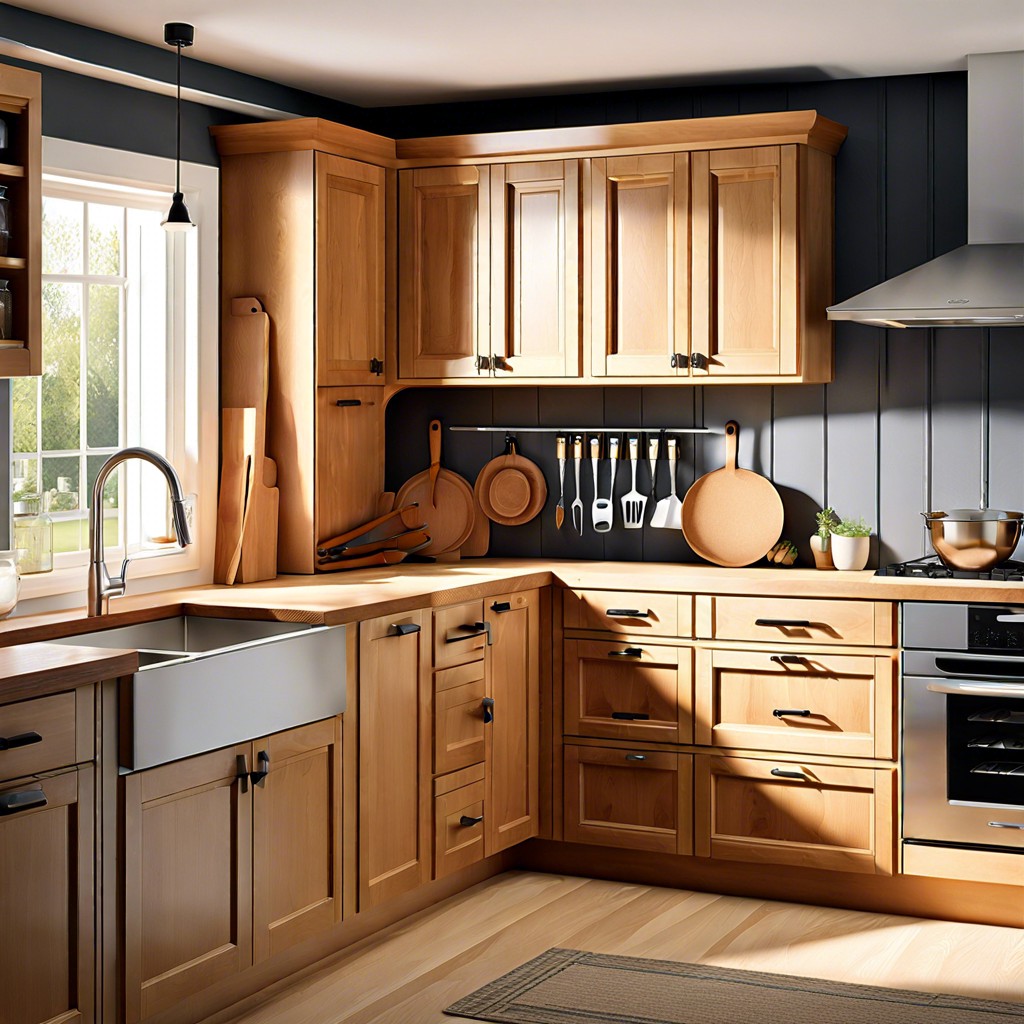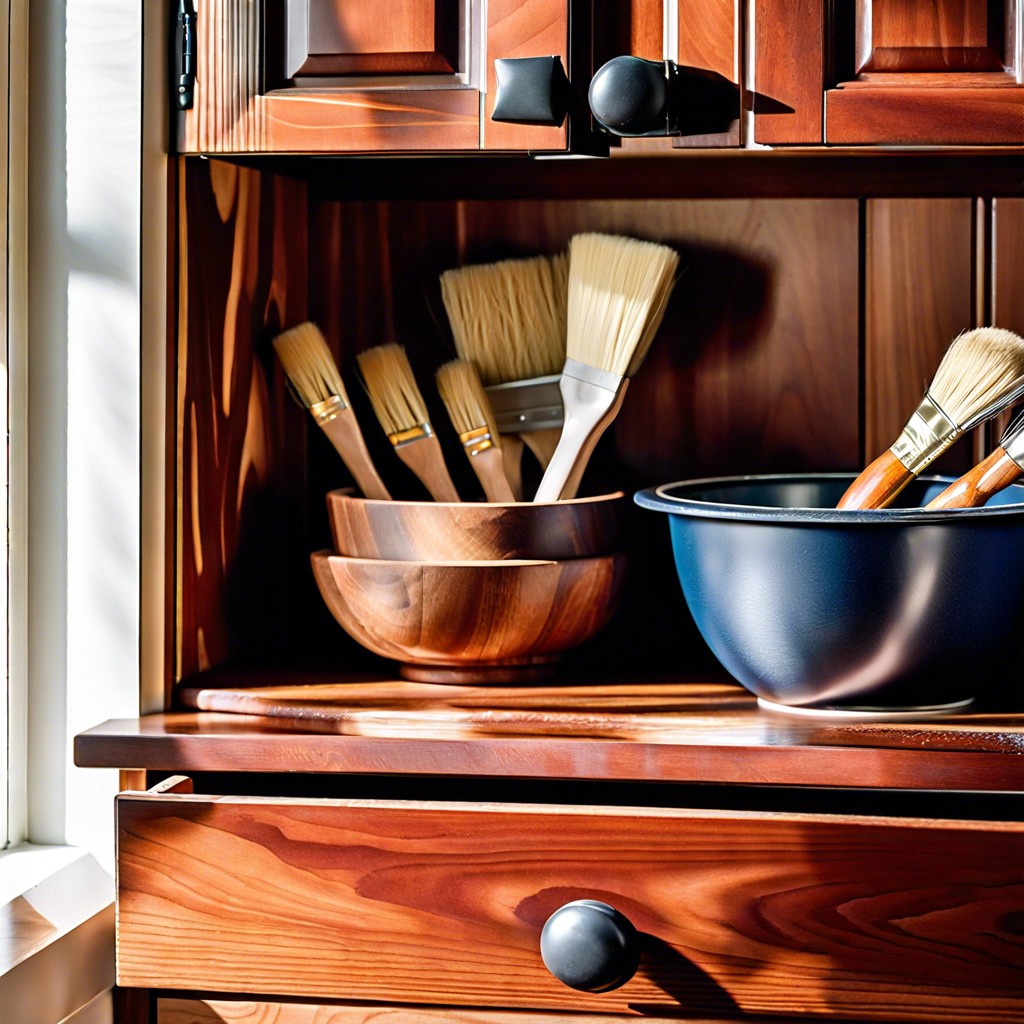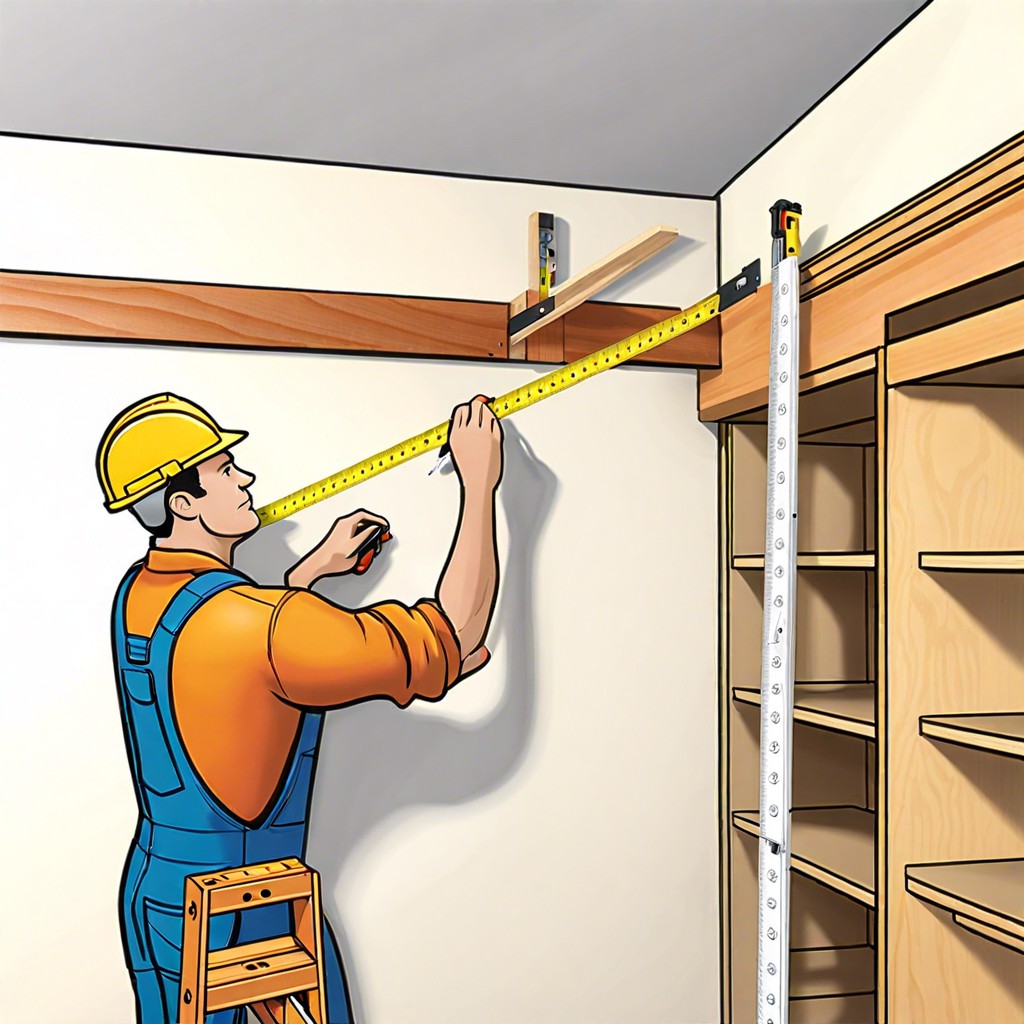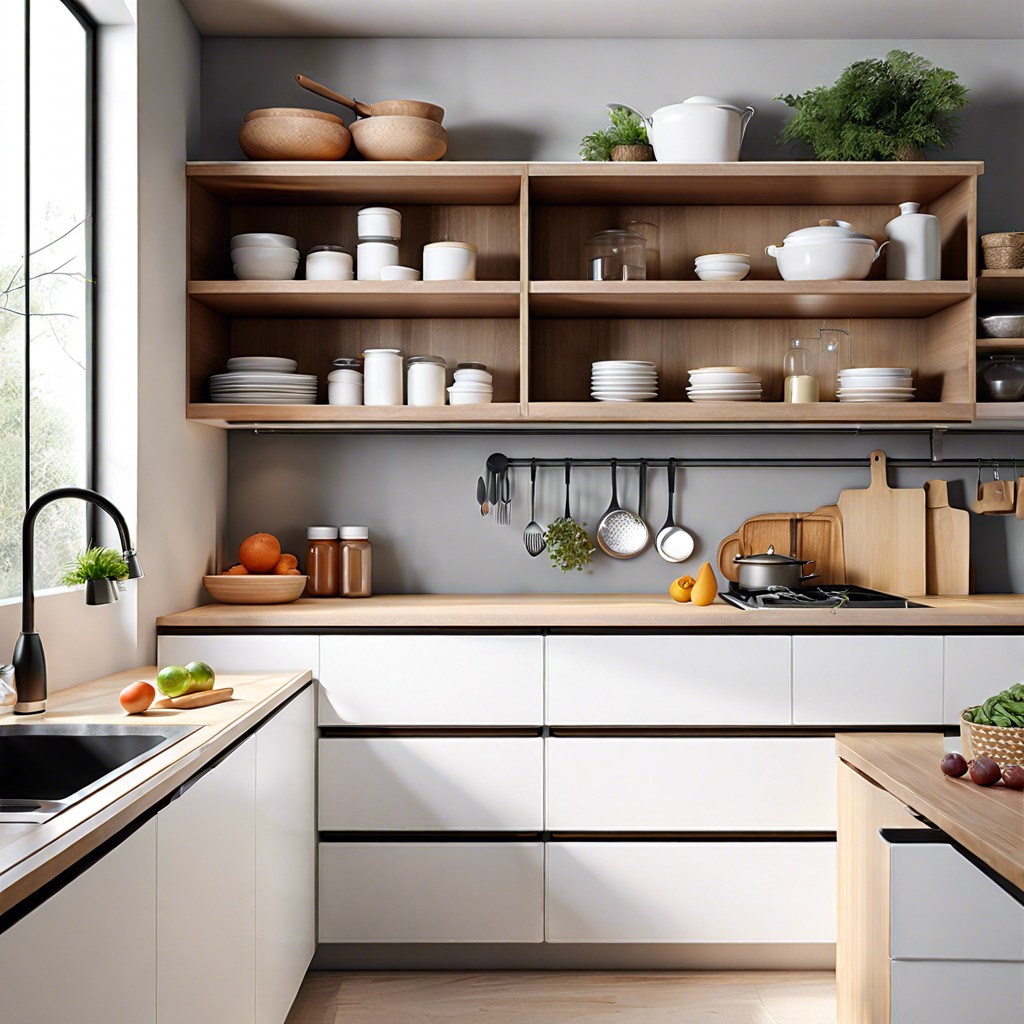Last updated on
Choosing the right kind of storage cabinet can transform a cluttered space into an organized sanctuary, but it’s crucial to understand the different types because each type serves a unique purpose.
Key takeaways:
- Base Cabinets: Sturdy, customizable, with doors and drawers.
- Wall Cabinets: Elevated, space-saving, customizable in size and finish.
- Pantry/Utility Tall Cabinets: Maximize floor-to-ceiling space with adjustable shelves.
- Materials and Construction: Solid wood, engineered wood, metal, plastic – choose based on needs.
- Custom Storage Solutions: Maximize space, adapt to specific needs, blend with existing decor.
What's Inside
Base Cabinets
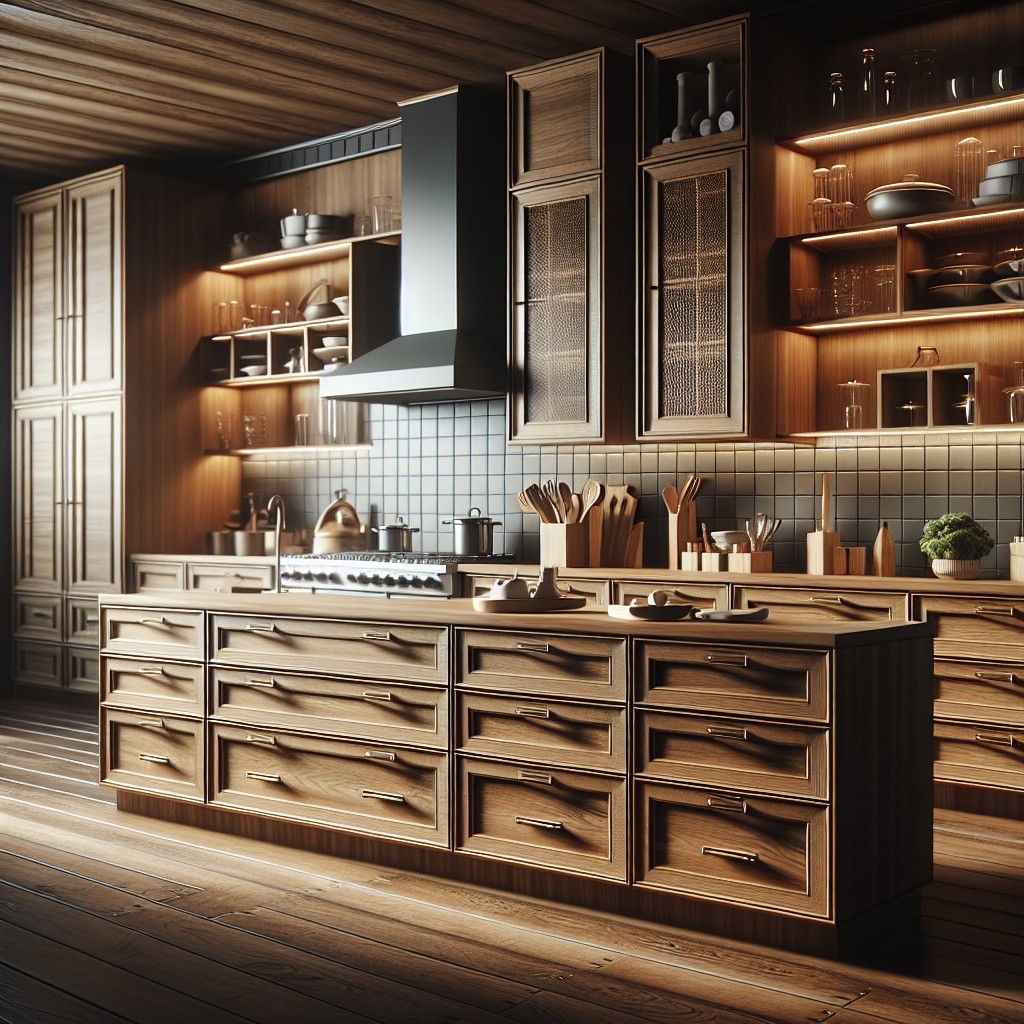
Designed to rest on the floor, these sturdy staples provide a foundation for countertops and a robust storage solution below. Typically ranging from 24 to 36 inches high and 24 inches deep, they allow for convenient access to pots, pans, or other heavy items.
Doors or drawers are common, with pull-out shelves and lazy Susans as popular features for enhanced functionality. They also house sinks and appliances, providing a seamless integration with the workspace above.
Height and depth variations cater to specific needs, from accommodating wheelchairs to providing extra-depth for more storage capacity. Installation often includes kickboards, hiding the cabinet’s feet and giving a clean, uniform look to your space.
Wall Cabinets
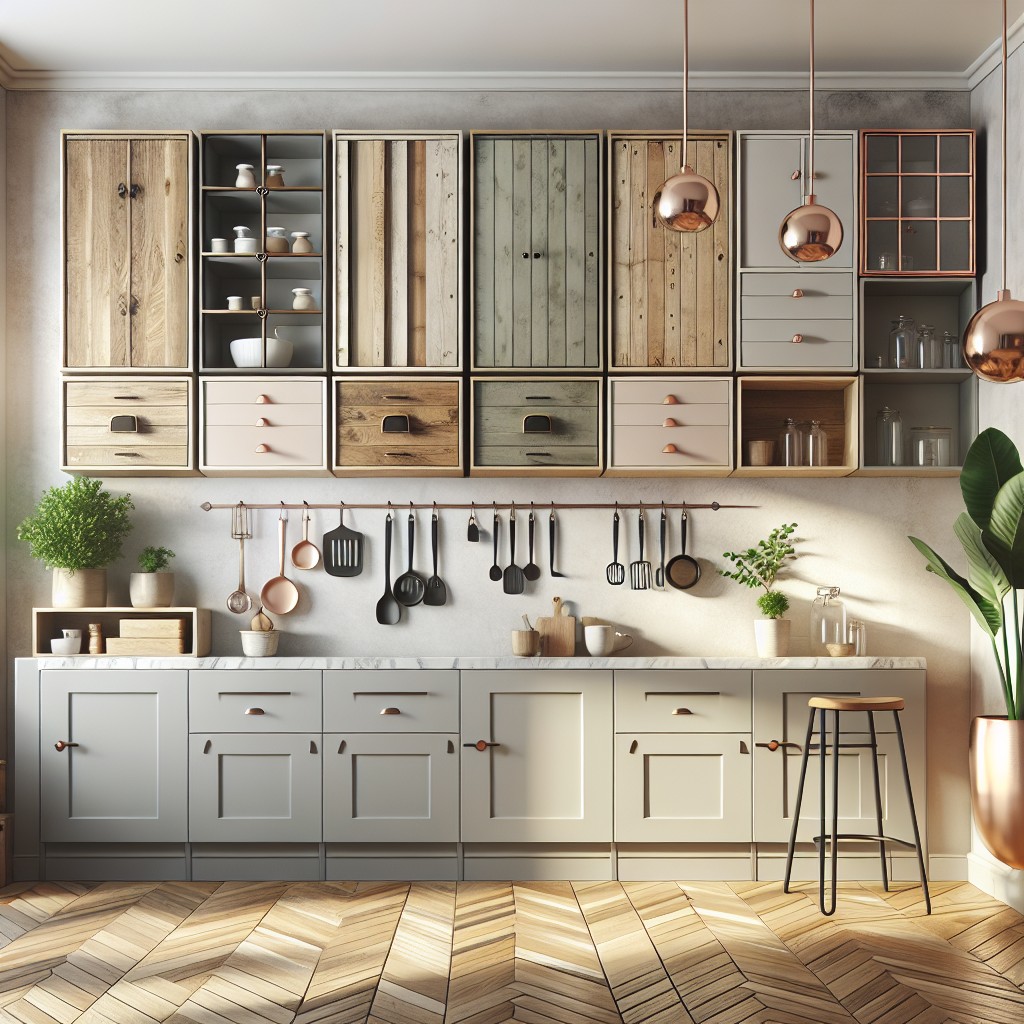
Elevating storage to eye level, wall-mounted options facilitate easy access while preserving floor space. Typically ranging from 12 to 18 inches deep, they are ideal for storing lighter items such as dishes in kitchens or toiletries in bathrooms.
Variations can include open shelving, glass-front displays, or traditional cabinet doors, offering both functional and aesthetic appeal. Installation height is key; positioning too high reduces accessibility, too low encroaches on counter space. It’s crucial to secure them to wall studs for safety, especially in seismic-prone areas.
Customizable in size and finish, they seamlessly integrate into diverse design schemes, making them a versatile choice for augmenting home storage.
Pantry/Utility Tall Cabinets
Maximizing floor-to-ceiling space, these cabinets come in various widths, often standing at heights of 84 to 96 inches. They provide ample room for bulk items and infrequently used appliances, making them ideal for stowing away goods in kitchens, laundry rooms, or basements.
With customizable shelving, they adapt to anything from canned foods to brooms and vacuums. Models with pull-out drawers or adjustable shelves enhance accessibility and visibility, ensuring no item is ever out of reach. Their vertical orientation makes them a fitting choice for narrow spaces, offering storage solutions without compromising on square footage.
Add-on features like door racks or specialized compartments for spices and bottles can further enhance utility, transforming them into multi-functional storage hubs.
Materials and Construction
Durable, high-quality materials are integral to the longevity and functionality of storage cabinets. Solid wood, known for its strength, offers a classic, timeless appeal but may require more maintenance. Engineered woods like MDF and particle board provide a cost-effective alternative, often found in flat-pack furniture, but may not withstand heavy loads as solid wood does.
Metal units, typically steel or aluminum, exude a modern vibe and stand up to rougher handling, making them ideal for garage or industrial settings. Stainless steel options resist corrosion and work well in damp environments or wherever hygiene is a priority, such as in medical facilities.
Plastic storage cabinets, while not as sturdy as their wood or metal counterparts, offer a lightweight and often less expensive choice suitable for spaces that don’t demand heavy-duty storage. They are also resistant to moisture, making them practical for basements or outdoor use.
Cabinet construction speaks to durability and user experience. Dovetail joints signify quality craftsmanship, ensuring that drawers can handle frequent use without falling apart. Cam-lock fasteners or dowels are common in ready-to-assemble furniture, making for easier home assembly at the expense of some stability. Soft-close hinges and drawer slides contribute to a higher-end feel, reducing wear and noise.
The choice of material and construction method impacts the cabinet’s lifespan, cost, maintenance needs, and suitability for certain environments. Consider these factors in the context of where and how the cabinet will be used.
Selecting the Right Storage Cabinet
When selecting the perfect storage cabinet for your space, take into account:
Purpose: Understand what you’ll be storing. Tools require sturdy materials and locks; linens need ventilation.
Size and Proportions: Measure your space. Ensure cabinets won’t obstruct pathways or doors.
Material Durability: Choose material based on the environment. Humidity calls for moisture-resistant materials like stainless steel or plastic.
Style: Match the cabinet to your room’s aesthetic. Modern spaces pair well with sleek designs; traditional rooms benefit from classic wood finishes.
Adjustability: Look for shelves that can be modified to fit items of different sizes.
Assembly and Installation: Consider ease of assembly. Some cabinets come pre-assembled, others require tools and time.
Budget: Set a realistic budget. Invest more for high-use areas, consider economy options for less critical storage.
Remember, the right choice blends functionality, space compatibility, and personal taste seamlessly.
Custom Storage Solutions
Embracing the concept of tailor-made spaces, custom storage solutions offer the advantage of personalization to fit unique dimensions and style preferences. Here are several key points about these bespoke options:
- They Maximize Space Efficiency: Every inch of available space can be utilized – awkward corners, high ceilings, or narrow hallways become valuable storage real estate.
- Adaptability to Your Needs: Whether you require more drawers, specialized racks, or a combination of different storage types, custom cabinets can be designed to accommodate your specific requirements.
- Aesthetic Integration: Custom solutions blend seamlessly with existing décor, maintaining design continuity and flow throughout your space.
- Long-Term Investment: Quality custom cabinetry tends to have a longer lifespan due to the use of superior materials and craftsmanship tailored to your use.
- Smart Features: Custom cabinets can integrate smart storage technologies, such as built-in charging stations or hands-free opening mechanisms, enhancing functionality.
Opting for a custom approach provides a solution that is as individual as your storage needs.
Organizing and Optimizing Storage Cabinets
Streamlining the interior of your storage cabinets maximizes space and accessibility. Start by grouping items by use and frequency. For seldom-used objects, consider the upper shelves or back of deep cabinets. Reserve eye-level shelves for things you reach for regularly.
Utilize clear bins and labels for a quick inventory and easy retrieval. Drawer dividers work wonders for small items, preventing them from becoming a jumbled mess.
Think vertically – stacking shelves and risers can double your shelf real estate. Hooks and pegboards inside cabinet doors offer hidden hanging storage for lightweight tools or accessories.
For deeper cabinets, pull-out shelves or baskets are game-changers. They allow you to bring items to you, eliminating the need to dig through dark, cluttered spaces.
Finally, regular audits keep your storage spaces efficient and clutter-free. Quarterly, reassess the content of your cabinets to ensure everything inside is useful and in its most practical spot.
Safety Considerations
Ensuring your storage cabinets are safe is crucial, not only to protect the contents but also to prevent accidents. When installing tall or heavy cabinets, anchor them securely to wall studs to prevent tipping, a must especially if you have children who might climb them.
For hazardous materials like cleaning supplies or sharp tools, locking mechanisms are advisable. Consider soft-close hinges and drawer glides to protect fingers from getting pinched. Always distribute weight evenly inside the cabinets, with heavier items on lower shelves, to maintain stability and ease of use.
Keep glass and delicate items in cabinets with solid doors or high shelves to avoid breakage. Regularly check all latches, locks, and mounts for wear and tear to prevent malfunction.
Maintenance and Cleaning
Keeping your storage cabinets in pristine condition not only enhances their appearance but also extends their lifespan. Dust and dirt accumulation can lead to scratches and damage to the cabinet surface over time. Here are some effective tips for maintaining and cleaning your storage cabinets:
- Regular Dusting: Use a soft, microfiber cloth to gently remove dust. Avoid abrasive materials that can scratch surfaces.
- Spot Cleaning: For spills or smudges, immediately wipe the area with a damp cloth and follow up with a dry towel to prevent moisture damage.
- Deeper Cleans: Use a mild soap and water solution for a more thorough clean. Make sure to dry completely to avoid warping or discoloration.
- Avoid Harsh Chemicals: Steer clear of bleach or ammonia-based cleaners that can strip finishes and weaken materials.
- Polish Wood Cabinets: Apply a wood-friendly polish every few months to nourish the material and maintain its luster.
- Metal Cabinet Care: For stainless steel, use a specialized cleaner to prevent streaks and maintain shine. For painted metal, a gentle all-purpose cleaner will suffice.
- Check Hardware: Periodically tighten hinges and handles to keep doors and drawers functioning smoothly.
Remember, different materials may require specific care instructions. Always refer to the manufacturer’s guidelines for the best practices tailored to your particular storage cabinets.
Sustainable Storage Solutions
Eco-friendly materials are at the heart of sustainable storage solutions, with bamboo, reclaimed wood, and FSC-certified wood leading the pack due to their renewable and recyclable nature. Opting for locally sourced materials not only reduces the carbon footprint but also supports the local economy.
The production process is equally important – manufacturers adopting low-emission and energy-efficient methods contribute to a cleaner environment. Additionally, look for non-toxic finishes and glues, which not only emanate fewer volatile organic compounds (VOCs) but are also better for indoor air quality.
Modular and adjustable designs extend the lifespan of storage units, allowing them to adapt to changing needs and reduce the urge to replace them frequently. This adaptability is key to reducing waste and promoting a circular economy.
In the realm of hardware, choosing durable handles and hinges ensures longevity. When hardware falters, it’s often easier and more sustainable to replace parts than the entire cabinet, so select cabinets with replaceable components.
Finally, consider the end-of-life scenario: storage pieces that can be disassembled for recycling or repurposed elsewhere minimize their environmental impact and promote sustainability beyond their immediate use.
Glass Door Storage Cabinets
Glass door storage cabinets offer a blend of functionality and aesthetic appeal. With their transparent nature, you can display your items while keeping them dust-free and organized. They are perfect for showcasing collectibles, fine china, or books, adding a sense of depth and brightness to any room.
These cabinets come in various styles – from modern to traditional – allowing you to match them with your home decor seamlessly. The glass doors can be clear, frosted, or patterned, depending on your privacy needs and design preferences.
In terms of practicality, they can also help you locate items quickly without needing to open the doors. To maintain a neat appearance, consider organizing contents in attractive baskets or with coordinated dishware. LED lighting inside can make your display even more striking.
For safety, tempered glass is often used, which is stronger and less prone to breaking than regular glass. If breakage occurs, it shatters into small granules, minimizing the risk of injury.
If you’re considering incorporating this cabinet style into your home, measure the space carefully to ensure the best fit, and be prepared for a little extra cleaning to keep the glass smudge-free.
Media Storage and Wall Units
Tailored to house your entertainment essentials, modern media storage units come in various configurations. Some are sleek consoles that anchor flat-screen TVs while providing shelves or cubby spaces for devices such as cable boxes and gaming consoles. Others include bookshelves and display cabinets, which flank a central area designated for the television, creating a comprehensive entertainment center.
Wall units take the concept further, transforming an entire wall into a multifunctional display. They blend open and closed shelving, perfect for exhibiting collectibles and art, with hidden areas for less display-worthy items. The intricate designs can incorporate desk spaces and bar units, making them the focal point of living spaces.
In selecting the ideal media storage or wall unit, consider the following:
- Size relative to the room to maintain balance without overpowering the space.
- Cable management systems to ensure a tidy appearance by concealing unsightly wires.
- Ventilation to prevent overheating of electronics.
- Adaptability to future technology upgrades or changes in media formats.
- Material and finish that complement the existing decor and provide durability.
By focusing on these aspects, you can achieve a harmonious blend of function and style, making your media hub both polished and practical.
Garage Storage and Utility Cabinets
Garage storage and utility cabinets are crucial for keeping tools, sports equipment, and various household items organized and out of the way. These cabinets come in a variety of materials, such as metal, plastic, and wood, each offering different levels of durability and aesthetic appeal.
Metal cabinets, typically steel or aluminum, are known for their strength and ability to withstand heavy loads, making them ideal for storing power tools or bulk supplies. They often have a lockable feature for added security, safeguarding valuable items.
Plastic cabinets offer a lightweight and rust-resistant alternative, suitable for damp environments. They’re easy to clean and move around, which can be particularly useful when rearranging the garage space.
Wood cabinets add a touch of warmth and can be customized to blend with the home’s decor. However, they may require more maintenance and are less resistant to moisture compared to their metal and plastic counterparts.
Adjustable shelves within these cabinets allow for the accommodation of items of varying sizes, from tall gardening tools to small jars of screws and nails. Wall-mounted options help to free up floor space, while freestanding units can be positioned to create work zones or define areas within the garage.
Incorporating these cabinets into a garage not only maximizes storage space but also contributes to a safer environment by reducing clutter that can lead to accidents. By choosing the right type and properly arranging them, one can transform a chaotic garage into a well-organized and efficient area suited for work and storage.
Office Storage Cabinets
In the professional realm, efficiency hinges on organization. Sturdy metal filing cabinets are classics, ideal for document security and fire resistance. Wooden models add warmth and blend seamlessly with office decor, offering a variety of finishes and styles.
Lateral files cater to wide paperwork, whereas vertical units capitalize on floor space. Open shelving units are perfect for quick access to resources and display purposes, while lockable storage ensures confidential items stay private.
Modular storage components can grow with your business needs, allowing customizable configurations. Mobile pedestals offer flexibility in a dynamic office environment, easily tucking under desks and rolling out for shared use. For collaborative spaces, credenzas and hutches provide both a work surface and ample storage. Overhead bins and cubicle shelves utilize vertical space effectively—crucial for compact office environments. With options ranging from high-density filing systems to sound-dampening tambour doors, ensuring a quiet workspace, selecting the proper office storage system is not just about capacity but also about functionality and enhancing workflow.
Kitchen Storage Cabinets
Maximizing space and efficiency is at the heart of kitchen storage cabinet design. Let’s break down some key points:
- Functionality First: Consider cabinets with built-in dividers, lazy Susans, and pull-out racks to make accessing items in the back easier.
- Personalization is key: Tailor your cabinets to your cooking style. If you bake often, a cabinet with a built-in organizing system for baking trays and ingredients can be immensely helpful.
- Accessibility: Opt for lower cabinets with deep drawers instead of shelves. They allow you to pull out the entire contents and see everything at once, eliminating the need to crouch down and rummage.
- Smart Use of Space: Don’t overlook narrow spaces. A vertical pull-out cabinet can be a spice rack or storage for cutting boards and baking sheets.
- Visual Harmony: Glass-fronted cabinets can display your dishes or glassware, adding a sense of depth and personal touch to the kitchen while keeping them dust-free.
Remember, the best kitchen storage solutions marry aesthetics with ease-of-use for a space that’s as enjoyable as it is functional.
FAQ
What are kitchen storage cabinets called?
Kitchen storage cabinets are commonly referred to as pantry cabinets.
What are the two main types of cabinets?
The two main types of cabinets are framed and frameless (also known as Euro style).
What is the best material for garage storage cabinets?
Considering durability and weight, the best material for garage storage cabinets is military-grade aluminum.
What is the difference between a pantry and a cabinet?
A pantry is typically used for storing bulk items and infrequently used products, while a cabinet is designed for regularly used essentials.
How can one effectively organize a kitchen storage cabinet?
One can effectively organize a kitchen storage cabinet by categorizing items based on use, size or frequency of use, using storage solutions such as shelf risers, spice racks, or turntables, and keeping like items together.
What factors should be considered when selecting materials for a bathroom storage cabinet?
When selecting materials for a bathroom storage cabinet, one should consider factors such as durability, moisture resistance, style, budget, and ease of maintenance.
What are the benefits of incorporating a linen cabinet into a bedroom design?
Incorporating a linen cabinet into a bedroom design offers the benefit of additional storage, helps in organizing linens neatly, and enhances the aesthetic appeal of the room.
